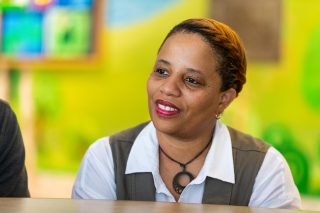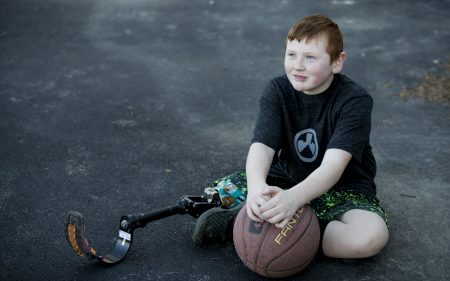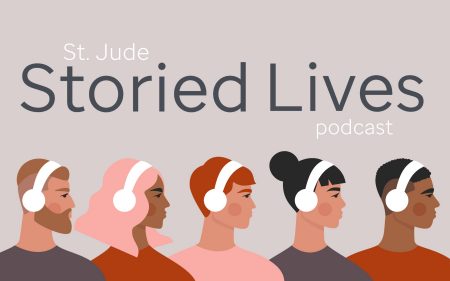
St. Jude making progress to subdue sickle cell disease
New advances have increased the life-expectancy for patients born with the blood disorder, and researchers now are driving toward cure.

June 14, 2021 • 7 min

Seventeen-year-old Khirsten never knows just when the pain will come, but she can predict with graphic precision the knife-like jabs it will bring.
“It feels,” she said, “like I’m getting stabbed a whole bunch of times back-to-back.”
If teenagers are famously prone to drama, there’s no hint of it in Khirsten’s voice. Her tone is steady and matter-of-fact while describing the piercing, debilitating pain produced by sickle cell disease, an inherited blood disorder she shares with one of her two sisters and an estimated 100,000 other Americans.
Pain, however, is just part of the burden weighing on sickle cell patients. They also can suffer fevers, infections, fatigue, strokes and organ damage. Typically, they die 20-30 years earlier than people who don’t have the disease.
As dangerous and relentless as sickle cell disease is, however, Khirsten and her 12-year-old sister Kaitlyn have benefited from therapies at St. Jude Children’s Research Hospital that help manage and minimize the pain crises while reducing organ damage.
The girls also are enrolled in a groundbreaking St. Jude study aimed at gaining insights into the progression of sickle cell disease, with the side benefit of giving patients important health screenings.
Although it is perhaps best-known for treating and developing cures for childhood cancer, St. Jude has been a pioneer in battling sickle cell disease ever since the hospital’s founding in 1962. Its first research grant, in fact, funded a study of the disorder. And in 1983, St. Jude achieved the first cure of a sickle cell patient through a bone-marrow transplant that also cured the same child’s leukemia.
Over the past quarter-century, advances developed by St. Jude researchers and funded by the research hospital's donors have factored significantly in increasing the average lifespan of sickle-cell patients by 98% — from the mid-20s to around 50. Now, St. Jude scientists are studying new therapies they say offer hope for a cure of the disease.
“St. Jude has been part of almost every single innovation that’s come out for sickle cell disease,” said Yvonne Carroll, RN, JD, director of patient services in the St. Jude Department of Hematology.
Battling the odds
For parents Christopher and Nichole, the bad news came during what should have been the most joyous of times. Just two weeks after the birth of Khirsten, their second daughter, they received a letter from St. Jude alerting them to the results of routine newborn screening: Their baby had sickle cell disease.
Sickle cell disease refers to a group of blood disorders that impair the flow of oxygen-carrying red blood cells throughout the body. People with the disease usually have a type of hemoglobin that forms hard fibers in the red cells, transforming those cells from oval into banana, or sickle, shapes that can get wedged into sticky clumps in blood vessels, cutting off the oxygen supply to tissues, muscles and organs.

Khirsten and her sister (background) Kaitlyn Bridges at a St Jude patient event.
“Every part of the body is affected — the heart, the kidneys, the spleen, the brain, the muscles, the eyes — it’s a progressive disorder,” Carroll said during a video discussion with donors last year. “It affects every part of their body, and it affects them their entire lives. And that’s why it’s so catastrophic.”
The disease is more prominent in those of African, Latin and South American descent; however, people of any race or nationality can have sickle cell disease, which is most common among descendants of people from Africa and other areas where malaria is pervasive. About 1 in every 365 African-Americans is born with it.
Khirsten’s parents were shocked to learn she had the disease, though Nichole had known she carried the sickle cell trait. What neither parent knew was Christopher carried the so-called hemoglobin C trait, meaning his red cells also contained abnormal hemoglobin. Together, the two parents’ traits added up to a 1-in-4 chance any pregnancy would produce a child with sickle cell disease.
As it turned out, the odds were even greater for Christopher and Nichole. Although their eldest daughter, Khristia, was born without the disease, Khirsten was diagnosed with it. Then, while Nichole was in the hospital with complications from Kaitlyn’s birth, she got a heartbreaking phone call about the results of newborn screening for her third child.
“To hear that news all over again,” Nichole said, “it was very devastating.”
The fruits of recent discoveries
With their early diagnoses, both girls began treatment as infants, starting with penicillin. St. Jude had been part of a pivotal early study showing that administering penicillin to children with sickle cell disease before they reached the age of two months reduces mortality by 84%.
That startling discovery led to sickle cell becoming one of the initial diseases for which newborns are screened, Carroll said, and it prompted the National Institutes of Health to declare it would be “unethical,” henceforth, to fail to give penicillin to babies born with the blood disorder.
By the time they reached the ages of 6 or 7, Khirsten and Kaitlyn began taking daily doses of hydroxyurea, a chemotherapy drug that has been used to treat sickle cell patients for some 20 years. Hydroxyurea boosts the level of fetal hemoglobin in red cells, allowing them to stay round and flexible so they can navigate tiny blood vessels more easily.
With better blood flow, there are fewer pain crises and infections. The drug also appears to prevent damage to the lungs, spleen, kidneys and brain.
As the girls grew, their parents encouraged them to participate in activities and pursue as normal of a childhood as possible. Still, the disease occasionally asserted itself. “It started out they didn’t have many crises,” Christopher said. “But as they got older they started having a lot more.”
Cold weather is a reliable trigger of pain. As blood rushes to the skin surface to keep the body warm, blockages often form. During a rare snowstorm in Memphis this winter, Christopher and Nichole allowed the girls to go outside, but for no more than 45 minutes.
Similarly, strenuous exercise can induce pain crises, as Khirsten discovered after joining the school track team. “Track has put Khirsten in the hospital for long periods of time,” Nichole said, “and she realized that may not be something she needs to do.”
Both girls are energetic, and their parents anguish at the restrictions they face.
“They both love to be out in the world,” Christopher said.
“That’s one of the hardest things that I think Nichole and I have to deal with. We see the life in them, we see the personalities, the things they want to do.”
Dealing with pain crises
Despite all the steps taken to prevent them, the crises still occur. And when the pain comes, it strikes “really deep,” Khirsten said.
“It’s not something you can just rub and be OK,” she said.
“Normally, it puts me out. I can’t walk, I can’t move. Basically, I can’t take care of myself. I’m stuck in the bed all day, or my dad’s having to help me walk to the restroom, stuff like that.”
Or, even worse, a stay of a week or so at St. Jude may be required. Doctors there make assessments and often use a saline drip to hydrate the body. The girls also get pain medication, although they don’t respond the same to certain drugs.
“Even though they both have the same disease, we’ve realized that the disease has affected Khirsten differently than the way it affects Kaitlyn,” Nichole said.
As St. Jude had demonstrated nearly 40 years ago, a bone-marrow transplant can cure sickle cell disease, but its use is limited. There are challenges finding a matched donor, and the procedure is associated with numerous complications.
With Khirsten’s older sister a close match for her, the family considered the option, but “the chances (for a cure) are not high enough for us to say, ‘OK, we’re going to put her through that,’” Christopher said.
The family, however, is seeing benefits from a new therapy administered as part of a study.
Khirsten is getting monthly infusions of a drug known as crizanlizumad, which, as a paper published in the the New England Journal of Medicine in 2017 reported, significantly reduces pain crises for sickle-cell patients. Since the infusions began, she’s been hospitalized only once, with most of the pain crises manageable with medicine. Kaitlyn is too young for the infusions.

Khirsten and Kaitlyn's mother.
Prospects for further advances
When she arrived at St. Jude in 1999, Carroll saw sickle cell patients faring much worse than today. More often than not, they died before reaching age 30. She saw 3-year-olds who had suffered strokes and had symptoms just like those seen in adult victims, including walking difficulties and drooping facial features.
“Not only that, you’d see the guilt from the parents and just the devastation from the parents from thinking they had done something wrong, that they didn’t see the signs or the symptoms,” she said.
In addition to its work on the penicillin study, St. Jude participated in early research that tested the use of a type of ultrasound of the brain to predict if a sickle-cell patient is at risk of a stroke. It has turned into a preventative measure “that has dramatically decreased the number of strokes in children with sickle cell disease,” Carroll said.
“And St. Jude just continues with these types of innovations.”
One of the most promising avenues of research now underway is gene therapy, which essentially involves replacing the defective gene causing the disease with a corrected copy.
“I think that gene therapy is going to revolutionize the treatment of sickle cell disease,” Carroll said.
In the meantime, St. Jude is conducting a number of initiatives to help sickle cell patients live longer and thrive.
The Sickle Cell Clinical Research and Intervention Program, in which Khirsten and Kaitlyn are participating, monitors how the disease progresses and provides health screenings. It also helps patients make the transition from the care they receive at St. Jude to adult care, which they’ll have to manage on their own. In the past, about half of sickle cell patients failed to make that connection.
“What we were finding, anecdotally, was that they were not surviving long after they left our care,” Carroll said.
And because sickle cell patients often experience cognitive setbacks that affect their schooling, St. Jude offers tutorial support and programs that help with reading.
For Christopher and Nichole, the initiatives and the research advances are sources of optimism for their daughters’ futures.
In fact, Christopher, who worked in a hospital unit in the Army Reserves, took a job as lab technician at St. Jude in part to contribute to the effort to subdue his daughters’ disease.
“I’m very hopeful that they will live normal lives and far exceed us,” he said.







